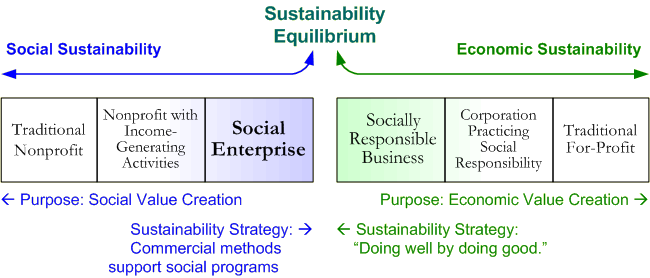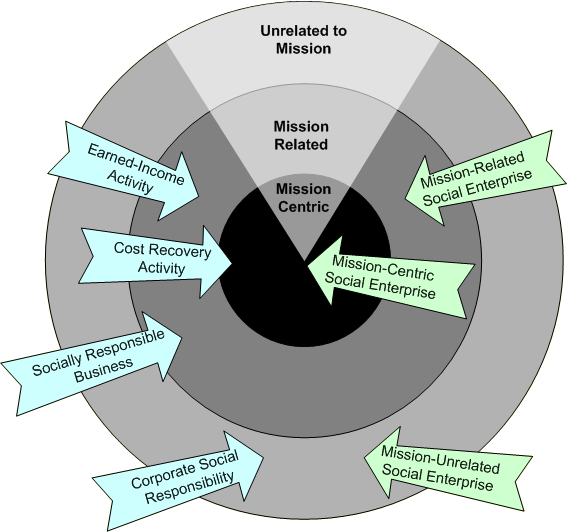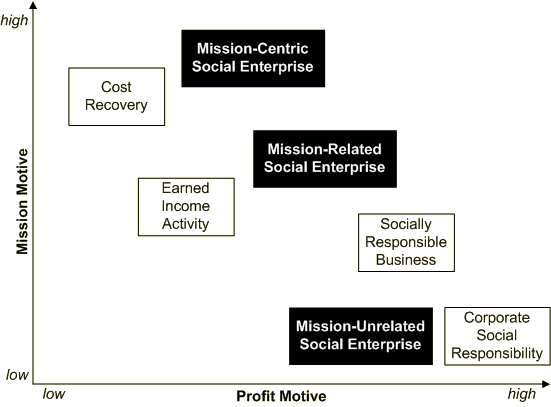Dual Value Creation
Dual Value CreationTwo distinct families of organizations reside on the hybrid spectrum. The characteristic that separates the two groups is purpose.
Profit (shareholder return) is the primary purpose of socially responsible businesses and corporations practicing social responsibly, whereas social impact is the primary purpose of social enterprises and nonprofits with income-generating activities. This difference is central to the organization’s ethos and activities. For this reason, organizations rarely evolve or transform in type along the full spectrum. Those that transform from social enterprise to socially responsible company or visa-versa must first reorient their primary purpose then realign their organization.
Nonprofits are founded to create social value, however, financial sustainability cannot be achieved without external or self-generated funds. For-profits are established to create economic value, yet often must make social contributions to survive in the marketplace. Therefore, both types of hybrids pursue dual value creation strategies to achieve sustainability equilibrium. Nonprofits integrate commercial methods to support their social purpose and for-profits incorporate social programs to achieve their profit making objectives.

As a hybrid, the social enterprise is driven by two strong forces. First, the nature of the desired social change often benefits from an innovative, entrepreneurial, or enterprise-based solution. Second, the sustainability of the organization and its services requires diversification of its funding stream, often including the creation of earned income.1
Distinguished by their dual value creation2 properties--economic value and social value--social enterprises have the following characteristics:
- Use business tools and approaches to achieve social objectives
- Blend social and commercial capital and methods3
- Create social and economic value
- Generate income from commercial activities to fund social programs
- Market-driven and mission-led
- Measure financial performance and social impact
- Meet financial goals in way that contributes to the public good
- Enjoy financial freedom from unrestricted income
- Incorporate enterprise strategically to accomplish mission
Duality of Objectives
 Social Objectives aimed at mission accomplishment (social value creation) vary widely depending the organization’s mission and sector. Examples include economic opportunities for the poor, employment for the disabled, environmental conservation, education, human rights protection, strengthening civil society, etc.
Social Objectives aimed at mission accomplishment (social value creation) vary widely depending the organization’s mission and sector. Examples include economic opportunities for the poor, employment for the disabled, environmental conservation, education, human rights protection, strengthening civil society, etc.
Financial Objectives focused on financial sustainability (economic value creation) vary according to funding needs and business model. Financial measures are drawn from both private and nonprofit practice. Examples include cost recovery of social service, diversifying grant funding with earned income, self-financing programs or making a profit to subsidize the organization's operations.
Blended Value
The concept of "blended value"4 arises from the notion that value has within it three component parts: economic, social, and environmental. While traditionally people have thought of nonprofits being responsible for social and environmental value and for-profits for economic value; in fact both types of organizations generate all three value sets.
The rise of social enterprise, corporate social responsibility, social investing, and sustainable development are all examples of how various actors are pursuing a blend of financial, social, and environmental value.5 The blended value proposition is drawn from the belief that "value" is inherently whole; hence this school of thought is moving from measuring multiple bottom lines to focusing on a single value sign-blended value-or "total value" creation.
More information about Blended Value is available on the Blended Value Map website.
- 1Reis, Tom. Unleashing New Resources and Entrepreneurship for the Common Good: A Scan, Synthesis, and Scenario for Action. W.K. Kellogg Foundation, January 1999.
- 2Formerly referred to as double bottom line concept; double bottom line was dropped in favor of a new more holistic value creation approach (see blended value). Many proponents of social enterprise, social investing, corporate social responsibility, and venture philanthropy subscribe to the triple bottom line which includes environmental impact along with economic and social impact. The intent of this typology is to simplify the concepts, rather than to discount the significance of environmental impacts. For our purposes environment impacts have been included within social impact category.
- 3Adapted from Gregory Dees, Enterprising Nonprofits, Harvard Business Review, January-February 1998.
- 4For more information see, Blended Value Proposition: Integrating Social and Financial Returns, California Management Review, Vol. 45, No. 4, Summer 2003.
- 5Excerpted from Mapping the Blending Value Proposition, Jed Emerson and Sheila Bonni, 2003.
Mission Orientation and Motives
Mission Orientation and MotivesIn hybrid organizations money and mission are intertwined like DNA; however, they are not always equal partners. In practice, financial and social objectives are often in opposition or competition with one another. The initial decision to undertake a social enterprise is frequently motivated by either financial need or mission benefit.
Mission Orientation in Hybrid Organizations
The following diagram shows the relationship between mission orientation and type of organization.

Mission vs. Profit Motives in Hybrid Organizations
The following scatter diagram shows the relationship between the type of organization and its motives.

Mission Drift
Mission DriftThe inherent challenge of operating a social enterprise is managing to its dual objectives. In practice, the business of generating social and economic value means decisions and actions are in frequent opposition. This translates into calculated trade-offs: decisions to forsake social impact to gain market share or increase profit margins; or conversely, expanding the scope of social good at a financial cost. Problems occur when an organization's enthusiasm to meet its financial goals begins to overwhelm its social mandate. Nonprofits' long history of struggling to secure funding can, in the advent of earned income, threaten to swing the pendulum too far in the other direction. In the early days of microfinance, donors and practitioners toiled to set parameters on "how far is too far" on the mission-money spectrum by quantifying loan sizes, duration of client relationships, and interest rates before arriving at a model that was both viable and scaleable.
The concern many nonprofit practitioners and donors face is that incorporating commercial approaches into a nonprofit will compromise the organization's mission or social services by causing a "drift" too far into the for-profit camp.
The feared results of the "drift" (real or perceived) are:
- drift may damage the reputation of the organization among stakeholders and the public;
- the social enterprise may jeopardize funding because donors either misunderstand its dual-intention social enterprise or believe donations are now unnecessary;
- it may threaten organizational culture by applying market-based approaches and bringing in business professionals and industry experts; and
- finally, some fear that the organization will lose focus, and stray too far into the commercial realm, neglecting its social mission.
Running a social enterprise is a balancing act, which requires vigilance and a clear understanding of the organization's purpose and priorities: what is the social impact that the organization is trying to achieve, and how much money does it need to make? It means strong market discipline coupled with an equally strong sense of ethics and integrity--and leadership consensus about limits on "how far is too far" in any direction. Generating economic value, or making money, is not an evil act; on the contrary, it's a tool for generating social value in a way that is more sustainable than relying on donor funds.
The social enterprise model and design will largely inform how its dual purposes are achieved; it is up to the leadership to manage the tensions. The following exhibit shows this relationship in the product and market mix.
Existing Product; Existing MarketIncome directly from social programs
Income is earned directly from nonprofit program activities. Nonprofit sells existing social service and products to its target market or to a third party payer on behalf of target market. Income covers the cost of service delivery and may fund all or a portion of overhead. Example: A microfinance institution sells micro-loans to low income microentrepreneurs. Income from interest and fees is used to cover the service delivery costs as well as the operating and financial costs of the microfinance institution. Highest mission relevance; lowest risk |
New Product; Existing MarketIncome from extension of social program
Income is earned by enhancing nonprofit program activities. Nonprofit sells new products and services to its existing target population or constituents. Income covers the cost of service delivery and may fund all or a portion of overhead. Example: In addition to its educational and advocacy programs, a biodiversity organization adds an exhibit hall to its offices. Visitors pay admission fees, which fund the operating costs of the exhibit as well as a portion of the organization's overhead. High mission relevance; medium risk |
Existing Product, New MarketIncome related to social program
A nonprofit commercializes its existing social services or products and sells them in the open market to the general public or businesses (other than to clients/constituents). Income subsidizes social programs and parent organization overhead. Example: A senior services organization provides grant-subsidized care management services to poor seniors, and sells the same services in its eldercare business to a private pay market. Income generated from the private eldercare business is used to subsidize social program costs and a portion of the parent organization's overhead. Medium mission relevance; medium risk |
New Market, New ProductIncome not related to social program
A nonprofit sells new products or services in a market other than to its target population or constituents. The decision to use this mix is financially motivated. This type of social enterprise most often takes the shape of auxiliary or unrelated businesses, and its income is used to fund social programs and the parent organization at-large. Example:
A youth organization owns a real estate holding company with several commercial rental properties. Space is rented to tenants that have no relationship with the commercial activities of the youth organization. Profit from the real estate business is used to fund the youth organization's overhead and programs. Low mission relevance; high risk |